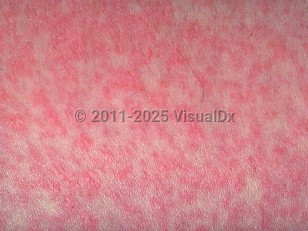Viral exanthem in Adult
Synopsis

During spring and winter, nonspecific eruptions can be seen with upper respiratory illnesses, often due to parainfluenza viruses, respiratory syncytial viruses, rhinovirus, and type A and B influenza virus. These are generally morbilliform in appearance, last for up to 2 days, and largely occur in children. Petechial lesions can also be seen in influenza and enteroviral infections when generalized.
The classic childhood viral exanthems come from diseases rarely seen in adults. These diseases were originally named numerically for the order in which they were discovered. Second disease (scarlet fever) is secondary to a bacterial infection and will not be covered in this section. Fourth disease is no longer felt to represent a distinct entity. Measles and rubella have largely been prevented by vaccination in industrialized countries; however, there has been a resurgence in measles in recent years in the United States, largely due to a decline in vaccination rates in certain communities.
First disease (measles, rubeola) occurs secondary to paramyxovirus. Third disease (rubella, German measles) occurs secondary to togavirus. Fifth disease (erythema infectiosum) occurs secondary to parvovirus B19. Papular-purpuric gloves and socks syndrome (PPGSS) is also caused by parvovirus B19 and typically occurs in young adults, but cases have been reported in children. Sixth disease (roseola, exanthem subitum) occurs secondary to human herpesvirus (HHV)-6 or HHV-7. Pityriasis rosea is also thought to occur secondary to HHV-6 and HHV-7.
A diffuse morbilliform eruption can also be seen following administration of amoxicillin or ampicillin in patients with Epstein-Barr virus (EBV). HIV seroconversion results in an erythematous exanthem in 50% of adults.
Exanthems and/or enanthems have been reported with COVID-19 and multisystem inflammatory syndrome in adults. See skin and oral mucosal manifestations of COVID-19 for further details.
The presence of vesicular lesions can raise concern for varicella-zoster virus (VZV) and hand, foot, and mouth disease (HFMD).
In immunocompromised patients, persistent or recurrent infections are a concern. Immunosuppressed patients can demonstrate chronic recurrent HFMD, persistent parvovirus B19 infection with chronic anemia due to persistent lysis RBC precursors, and disseminated VZV. Immunosuppressed patients can also present with an altered presentation. Measles can present without a viral exanthem or with a mild exanthema in patients with congenital or acquired T-cell defects. In primary and secondary T-cell deficiency, there is an increased risk of severe varicella that may be hemorrhagic, may disseminate systemically, and may be fatal.
In pregnant patients, the presence of a viral exanthem raises concern for a select group of infections that can have consequences on fetal development. Parvovirus infection can result in nonimmune fetal hydrops, fetal death (particularly with infection in first trimester), and miscarriage. Rubella infection (most susceptible in first and second trimesters, variable clinical picture in third trimester) can result in congenital cataracts and "blueberry muffin" skin lesions. These violaceous papules can also be seen in TORCH syndrome (Toxoplasma, other infections [such as HIV], rubella, cytomegalovirus, and herpes simplex).
In returning travelers, infectious diseases such as chikungunya, dengue fever, Zika virus, yellow fever, West Nile virus, Lassa fever, and South American hemorrhagic fever may be causes of viral exanthems.
Codes
B09 – Unspecified viral infection characterized by skin and mucous membrane lesions
SNOMEDCT:
49882001 – Viral exanthem
Look For
Subscription Required
Diagnostic Pearls
Subscription Required
Differential Diagnosis & Pitfalls

Subscription Required
Best Tests
Subscription Required
Management Pearls
Subscription Required
Therapy
Subscription Required
References
Subscription Required
Last Updated:08/04/2025
 Patient Information for Viral exanthem in Adult
Patient Information for Viral exanthem in Adult- Improve treatment compliance
- Reduce after-hours questions
- Increase patient engagement and satisfaction
- Written in clear, easy-to-understand language. No confusing jargon.
- Available in English and Spanish
- Print out or email directly to your patient


